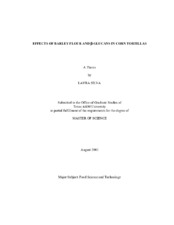| dc.description.abstract | The effects of b-glucan on corn tortilla texture were evaluated. Barley flour (9.7% b-glucan) was substituted at 2.5, 5 and 10% for dry masa flour in corn tortillas. Texture was evaluated after 4 hr and up to 7 d storage at 4°C. Substitution of 2.5-10% barley flour significantly improved tortilla texture.
Combined effects of barley flour (0-2.5%), maltogenic amylase (0-1650MAU) and carboxymethylcellulose (0-0.5%) were evaluated using surface response methodology. Barley flour increased rollability, pliability, energy dissipated and reduced rupture force and final stiffness. Overall, maltogenic amylase decreased rupture force and Young's modulus but decreased rupture distance, rollability and pliability at levels above 825 MAU. CMC improved rollability, pliability, and rupture distance. The best response was found using barley flour and CMC with 825 MAU, where rollability, pliability, rupture distance and energy dissipated increased while rupture force, Young's modulus and final stiffness decreased.
A 70% barley b-glucan concentrate combined with amylase (550 MAU) or CMC (0-0.5%) was evaluated in corn tortillas. Amylase combined with b-glucan did not improve texture. Tortillas with b-glucan and CMC had significantly improved pliability, rollability, final stiffness and energy dissipated.
Texture measurements analysis showed that depending on the stage of storage, objective and subjective methods correlate differently. Subjective and objective measurements of texture were not correlated at 4 hr storage. At the end of storage, pliability had significant correlations with stress relaxation measurements, but rollability had higher correlation coefficients with extensibility measurements. Pliability had higher R2 and lower coefficients of variation compared to rollability.
Sensory evaluation was conducted using reheated 14-day-old tortillas of control, 825 MAU with 0.25% CMC, 0.12% b-glucans, 0.18% b-glucan with 0.375% CMC, and 0.24% b-glucan with 0.25% CMC. All tortillas had similar appearance, flexibility, gumminess, flavor and overall quality. Softness and chewiness of treatments with 0.12% b-glucan or 0.24% b-glucan with 0.25% CMC were similar to control. Other tortillas were significantly tougher and chewier.
b-glucan may be the active ingredient in barley flour that modifies firming of corn tortillas during storage. Barley flour is inexpensive and effectively improves texture of corn tortillas. | en |


